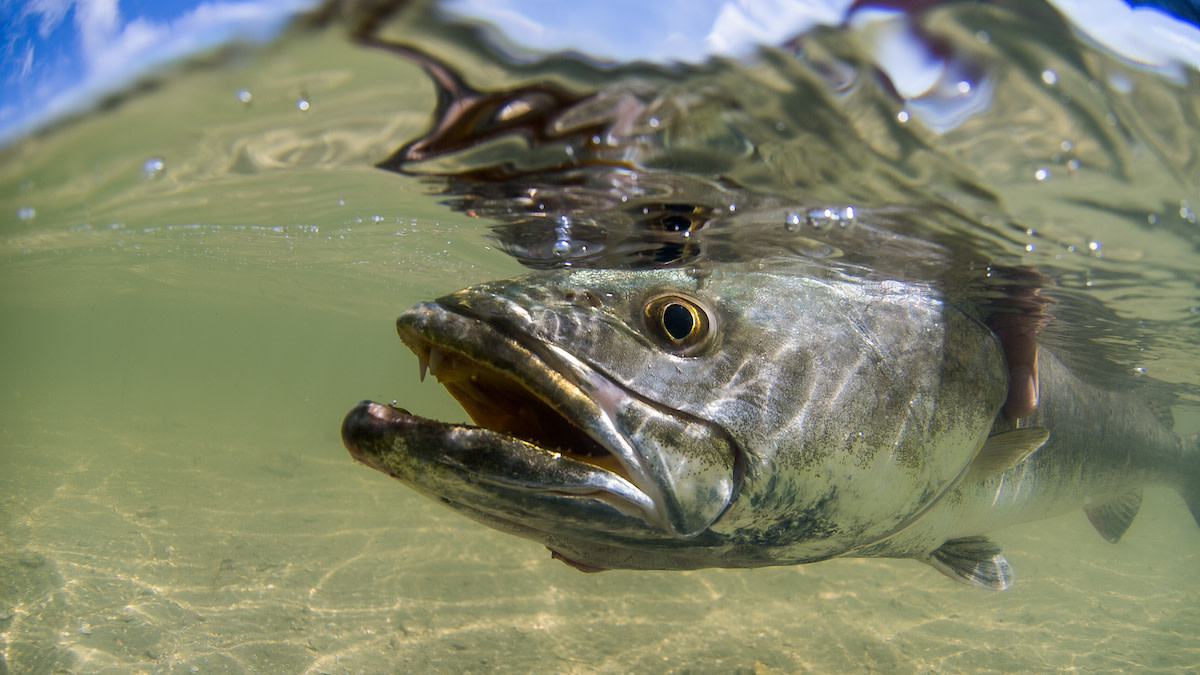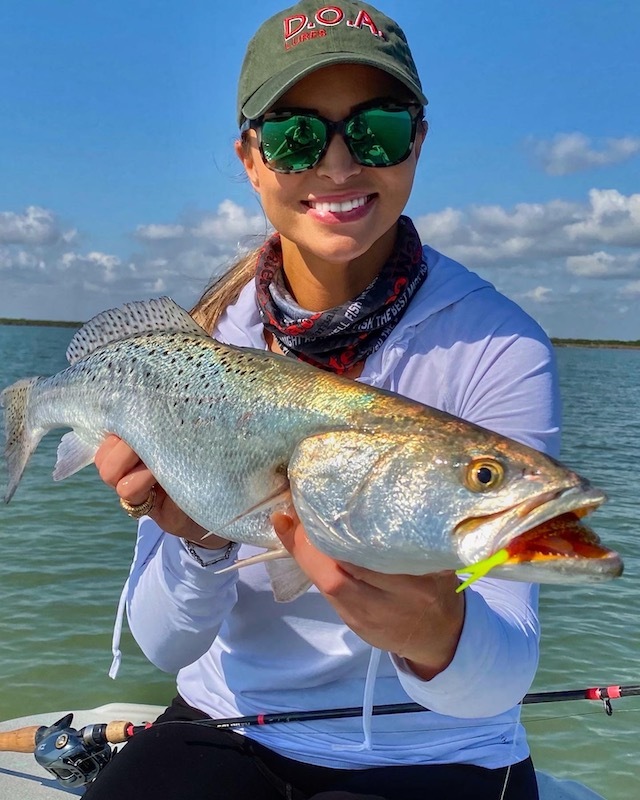
Silver flank, purple hues, black spots, an opalescent flash beneath the water.
There's no mistaking one of the most popular inshore sportfish along the East and Southeast coast: the speckled sea trout. While specks are great fun to catch, their highest value might be their oh-so-tasty white, flakey meat.
The speckled sea trout’s name may be misleading because it is not actually a trout like a rainbow or brown. These fish, Cynoscion nebulosus, are actually members of the drum family, Sciaenidae, closely related to redfish and black drum. The proof is how male trout make a drumming noise with their air bladders. These fish have a predisposition for hitting natural and artificial baits, as well as flies, and carry a reputation for being delicious table fare. Both claims to fame make the species highly sought after.
Where to Find Sea Trout Sea trout can be found along the Gulf Coast, around Florida, and up to the mid-Atlantic, from Texas to Maryland. Most anglers target these fish in shallow, inshore waters, but they can also be found offshore and even up some rivers.
Whether you are on the hunt for trophy-sized or eating-sized, your habitats should be similar. While trophy trout are exhilarating to land, they aren’t exactly the size you want to throw on your stringer or in your cooler. They’re more suited for gentle care and C.P.R (catch, photo, release). Like the adage says, “let ‘em go, let ‘em grow.” Generally, anything above 23 inches is considered a breeder fish which our estuaries rely on to keep populations sustainable.
Where you search for specks directly correlates with what is on their mind, which is usually one of three things: their next meal, taking shelter, and not getting eaten. With this in mind, you begin your hunt for speckled sea trout.
Grass flats are ideal spots to search during warmer weather. Your mission is to fish shallow areas early in the morning and late in the evening. In the heat of the day, move with the trout to deeper areas, specifically the drop-offs around grass flats and channels. When the weather is moderate, the fish may remain in shallow water for a longer portion of the day. During winter and late spring, shallow grass flats are key. Trout get skinny with large schools of mullet as a defense against predators trying to sneak up on them.
Oyster bars and beds are critical habitat for crabs, shrimp, and baitfish. Trout situate themselves around these oyster beds to forage, because while oysters provide relief and cover for small baitfish, they also provide a break in the current and give trout the perfect spot to sneak up and ambush their prey.
Mother Nature gives us a couple pointers about when and where trout are feeding. When they are schooled up and hungry, they will push balls of baitfish to the surface. Seagulls and other birds circle above a trout feeding frenzy and plunge into the water to strike baitfish from above, a dead giveaway for anglers that can be seen from afar. Targeting areas with working birds will result in some by-catch, occasionally even birds, but the reward outweighs the risk.
If you’ve heard of or seen oil slicks, you’ll learn to watch and sniff for trout slicks, too. Sea trout often regurgitate when they’re excited during feeding and the oils from partly digested food surge to the surface to make a visible sheen. The odor of a trout slick has been compared to watermelon by some. Commonly, the smaller the slick, the more recent it was created. As the slick sits the oils disperse and spread out with the current, making the slick wider. Keep in mind: trout slicks tend to be an oval shape while bait slicks are lengthier and stringy. You should fish both small and large slicks but try to key in on the smaller ones as specks are likely still looking for their next meal.
Best Lures and Baits for Sea Trout Sea trout are very opportunistic feeders, which means anglers can be successful using artificial lures, live bait, and flies.
The right finesse touch with a lure can ignite a reaction strike from even the most gorged sea trout. My go-to arsenal of artificial lures for speckled trout are DOA shrimp. These plastics are perfectly designed to mimic the erratic motion of a fleeing shrimp with a twitch-twitch-pause action. The fish can’t seem to resist.

It also never hurts to go back to the basics with a fluke or soft-plastic jerk bait of 3 or 4 inches. I’m partial to the Texas Croaker color (purple plum body, chartreuse tail) on a 1/16- or 1/8-ounce jig head depending on water depth. You can also fish topwater over oyster bars and shallow flats during high tide to attract deadly strikes from larger speckled sea trout, especially early and late in the day or on days when there is plenty of cloud cover. A topwater plug convincingly mimics an injured mullet, one of the speckled sea trout’s favorite victims. Yo-Zuri’s Topknock Pencil has been a very productive lure. Many folks consider the MirrOLure Fatboy Corky a winter and early spring favorite. This lure perfectly imitates a shad which, during the colder winter months when smaller bait fish are scarcer, is ideal.
For live bait, shrimp are both easy to find in bait shops along the coast and high on the menu for speckled trout. Popping corks are an incredibly effective to present shrimp. The float or cork makes a popping sound when you twitch it on the surface, which simulates fish feeding and draws trout to the noise. Popping cork rigs are very versatile and can be fished with both live bait and soft plastics. If using live shrimp, tie a standard saltwater hook to the leader. If you’re throwing soft plastics, use a 1/8- or 1/4-ounce jig head.
While it’s controversial, depending on what state you are in, small croaker are also a common baitfish used for trout during the late spring and early summer. Fishing with croaker, which can be substituted with piggy perch, limits the amount of non-target fish you may encounter. Speckled trout can’t resist the smell and presentation of a croaker. When fishing croaker, use a Kahle or “K” hook and rig it through their back right on the lateral line. This will keep it alive and swimming freely. You can also rig the hook through the nose of the croaker when fishing deeper water. Select the size of your hook based on the size of the fish in batch of croaker you picked up. Usually 2/0 or 3/0 is preferred.
Fly selection for sea trout is relatively simple and matches many of the same colors and patterns anglers commonly use for other popular inshore species like redfish and snook. Simple, sparse streamers that evoke common forage fish and crustaceans are key, such as the Clouser Minnow or EP Baitfish. Many fly anglers chose white or drab, natural colors but you can get more adventurous with hue selection.
Techniques for Sea Trout Wade fishing makes you much stealthier and allows you to be very thorough when fishing any area. It also keeps you in tune with subtle changes you might miss fishing on a boat, such as water temperature variations, change in bottom composition, and the pull or direction of the tide.
Boats are without a doubt helpful for reaching remote areas and working through water efficiently. Flat skiffs are the gold standard, but johnboats and kayaks provide awesome opportunities too. When you’re on a boat, whether you use a trolling motor in deeper water or drift socks and push-poles in shallow water, a slow, steady drift will allow you to cover area and not spook fish.
Fishing for trout in the surf is a blast, but almost entirely dependent on the wind and weather. Ideal conditions for fishing the surf are calm wind and good water clarity, since trout are visual feeders. Long casts are key whether you are wade fishing, on a boat, or fishing the surf.
Gear for Sea Trout Speckled sea trout can be quite evasive with their head shakes, making them notorious for spitting hooks. Having the right gear to land your fish is important. The humbling thing about trout fishing is you don’t need heavy tackle—this is very much a light gear game.
I predominantly use braided line with a double Uni knot to a fluorocarbon leader. Braid will really help you feel what’s on the end of your line. My go-to rod when trout fishing is 6-foot 6-inch medium-power, fast-action baitcasting rod like the 13 Omen Green or Waterloo Ultra Mag.
Whether you prefer casting or spinning rods, a lightweight, fast-action rod is perfect for this technical style of fishing. You want your rod to be light yet have the backbone for chucking large plastic baits, topwaters, and live bait a country mile while also still possessing the muscle and finesse to feel even the subtlest bite.
As many know or have figured out the hard way, specks have big, mean teeth that they’ll try to use on you, given the opportunity. The best solution for this is a pair of lip grippers when removing hooks. They’ll limit the amount of contact you have with the trout so as to avoid removing its slime (which is critical to its overall health should you decide to release it), and they’ll also give you a better chance of getting your hook out of smaller trout.
Fangs sound pretty cool on a fish, right? Not when they sink into your fingers or hand. Pliers or forceps come in handy when trout fishing to prevent any unnecessary cuts or scrapes. I’ve gone toe-to-toe with speckled trout teeth many times and I will gladly bow out of that experience again by using long, sturdy pliers. If it’s a smaller trout, I encourage you to use your hand or forceps because pliers can harm the fish you may be releasing. You want to prevent any unnecessary casualties when dealing with this great sportfish, whether you’re releasing it back into the saltwater or into hot oil that night.
Feature image via Tosh Brown



